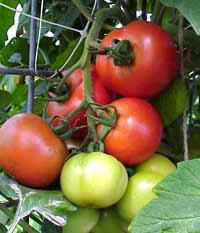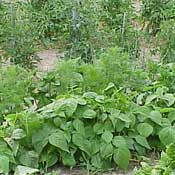|
How do you choose
among all those luscious-sounding tomato varieties? (Especially if
you are looking at seed catalogs on a cold January day...) Though
there’s nothing wrong with choosing a variety because you like
its name or how it looks, you may want to consider some other characteristics
that can make your job as gardener a little easier.
Disease
Resistance
There are cultivars (cultivated varieties) of many garden plants that
have shown resistance to certain pests. If you know a pest is common
in your region, by all means choose a resistant variety. If you don’t
know what pests you might encounter, you might want to plant a few
disease-resistant varieties anyway, just in case your non-disease-resistant
choices succumb.
Short-
or Long-Season Varieties
If you like to
have the first ripe tomato on the block, or you live in a region with
relatively short summers, choose varieties that mature the fastest.
Some tomato varieties, for example, ripen are ready to begin harvesting
60 days after transplanting, while others need 85 days or more to
mature.
Growing
Habit
Choose plants with growing habits that match
your needs. Bush beans, as the name implies, grow as small, free-standing
plants, while pole beans need something to climb. Some types of squash
grow in compact form, while others need lots of space for their vines
to run. There are rambling, vining nasturtiums and tidy, mound-forming
varieties.
Hybrid
or Open-Pollinated
Plant
breeders create hybrid plants by cross-breeding two different varieties.
Hybrid plants often are more productive and disease-resistant than
non-hybrid
("open-pollinated")
varieties. However, there’s a drawback. If you like to save seed
at the end of the season for planting the following year, avoid hybrids.
Their seed doesn’t come true -- that is, the resulting plants
may not have all the characteristics of the parent plant.
Of course, if
you have some favorite varieties, go ahead and plant them, even if
they aren’t the most logical choices. Brandywine tomato has no
particular resistance to diseases -- but if you manage to keep yours
healthy, the reward will be one of the tastiest tomatoes on earth!


Class
1, Page 1 2
3 4 5
6 7
Copyright 2002,
National Gardening Association. All Rights Reserved.
For questions regarding this web site, contact Webmaster
|
|

There are thousands of tomato varieties to choose from. Refer
to the seed packet or catalog description to learn about a particular
variety's disease resistance and days to maturity.
|
|
Gardening
Basics FAQ #2
What does
it mean when a variety is described as an "heirloom"?
Answer
|
|

Bush beans grow as small, free-standing plants ...

... while pole beans grow as long vines and need a support
to climb.
|
|